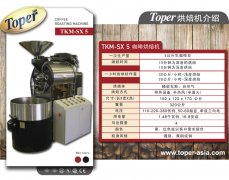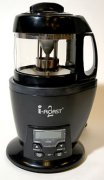Coffee information DIY self-made 13 coffee roasters

DIY self-made coffee roaster
People who are used to instant coffee cannot understand how much "coffee control" people pay attention to a cup of coffee, while a professional "coffee control" has special requirements for each link. In a cafe on Li Huangpi Road, the shopkeeper who turned out to be a mold worker brought his specialty to the coffee, and even the coffee roaster played DIY.
Recently, because of the cat named Doudou in the store, Mojie Coffee has become a little popular, but many cat fans are more or less surprised when they get into this cafe. Doudou lounged on the sofa on the second floor, letting you feel free to pat is silent, this lazy cat's sense of existence is so weak that it really does not let the cafe take it as its theme.
When walking into this cafe for the first time, many people will be attracted by the decoration of the store. The red brick house on Li Huangpi Road, the green wall surrounded by dozens of plants in front of the store, and the small aquarium in the window. Coupled with the old telephones, radios, typewriters and accordions that can be seen everywhere in the store, if it were not for the extremely fast speed of Juanzi, the store manager, it would really give people the illusion of going back in time.
But there is also a hidden treasure in the store, which I am afraid many people have not noticed, and that is the coffee bean roaster made by the shop owner Li Jun. The stainless steel bowl removed the bottom of the bowl and transformed it into the entrance of raw coffee beans. As soon as the thick pressure cooker was opened, it became a space for baking coffee beans. The door handle of the four cabinets in the store was removed and became the doorknob of the coffee bean exit. A computer chair was torn down to the pillar of the lift, which became the "foot" of the roaster. The most mixed one was the base of the roaster, which was a genuine street lamp base. It's the same as everyone saw on the road. The machine was made by the shopkeeper in imitation of an old German roaster in the 17th century, and the whole machine was completed without stopping every day for several months.
However, Juanzi is commonly used by another baking machine designed by the shopkeeper. By contrast, the original machine is much more simple in appearance. In the glass cabinet, an electric stove is surrounded by iron sheet, and the leakage net commonly used in the kitchen is relatively buckled up. It is the main part of roasting coffee beans, and the heat size and time are all controlled manually.
Li Jun himself has DIY 13 various kinds of baking machines, some of which are made for friends. After continuous improvement, his DIY level is getting higher and higher.
Now, the three stores of Mojie Coffee all use homemade coffee roasters. To save money, the production costs of these machines are not small, so why not buy a roaster directly after such a great deal of DIY? Juanzi pointed out the reason: "the machine bought is quite rigid and can only be done according to its program, but coffee beans from different places have different baking requirements, and everyone has different baking habits, so it is easy to master the machines made by themselves." In addition, the capacity of their DIY machines is not large, so they can bake as much as they use to ensure that the cooked coffee beans are used up within a week. "the freshness of beans directly determines the quality of a cup of coffee, which is more important than the origin."
Important Notice :
前街咖啡 FrontStreet Coffee has moved to new addredd:
FrontStreet Coffee Address: 315,Donghua East Road,GuangZhou
Tel:020 38364473
- Prev

Introduction of TOPER TKM-SX 55kg coffee roaster
Coffee roaster for teaching and competition TOPER 5kg coffee roaster
- Next

Coffee roaster introduction of hot air household roaster
Model: i-ROAST 2 Coffee Roaster (hot air household roaster) Brand: i-Roast specification: length / width / height (9/9/32cm) gross weight 2.7kg 150g baking quantity Power: 230V Power: 1500W characteristics: the most popular household roaster with full function, easy to use, suitable for coffee players to bake coffee with personal characteristics and taste. 150g coffee can be baked each time.
Related
- What is the Philharmonic pressure? How to use Philharmonic pressure to make delicious coffee
- Why does a hand grinder have more fine powder than an electric grinder?
- In addition to the hot mom, what is the difference between the versions of EK43 | ditting and Mahdi ek43?
- What kind of equipment do you need to make coffee by hand? Introduction to novice starter cooking equipment tools
- Espresso needs to be ground how thick and thin scale entry Italian Coffee Machine Bean Grinder investigation and Grinding course
- How much does it cost to open a small private cafe? How much does it cost to learn coffee? How to operate it?
- The difference between the flavor characteristics of hand-brewed coffee and coffee maker is hand-brewed coffee really better than coffee maker? Can I use a coffee machine to make coffee beans by hand?
- The difference between 01 and 02 of hario v60 filter cup what is the difference between 01 and 02 filter cup opening and cooking flavor
- What's the difference between the smart cup and the French kettle? Which is better, the French kettle or the Smart Cup?
- What's the difference between a smart cup and a V60 filter cup? The difference between the taste of smart cup and hand-brewed coffee

